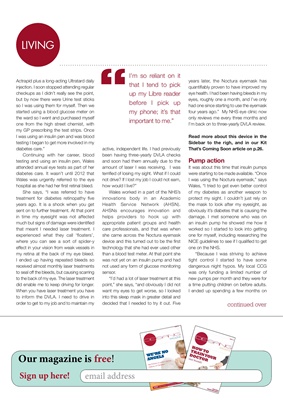
LIVINGLIVING
ISSUE 30
MAGAZINE
DESANG
PLUS • New Products • Groovy giveaways • News (for T1 and T2)
WE'RE NO
ANGELS
But business as usual is best for
diabetics at Christmas
MAKING
CARBS COUNT:
CHESTNUTS ROASTING
ON OPEN FIRES
Our magazine is free!
Sign up here! email address
Actrapid plus a long-acting Ultratard daily
injection. I soon stopped attending regular
checkups as I didn't really see the point,
but by now there were Urine test sticks
so I was using them for myself. Then we
started using a blood glucose meter on
the ward so I went and purchased myself
one from the high street chemist, with
my GP prescribing the test strips. Once
I was using an insulin pen and was blood
testing I began to get more involved in my
diabetes care."
Continuing with her career, blood
testing and using an insulin pen, Wales
attended annual eye tests as part of her
diabetes care. It wasn't until 2012 that
Wales was urgently referred to the eye
hospital as she had her first retinal bleed.
She says, "I was referred to have
treatment for diabetes retinopathy five
years ago. It is a shock when you get
sent on to further treatment. At that point
in time my eyesight was not affected
much but signs of damage were identified
that meant I needed laser treatment. I
experienced what they call 'floaters',
where you can see a sort of spider-y
effect in your vision from weak vessels in
my retina at the back of my eye bleed.
I ended up having repeated bleeds so
received almost monthly laser treatments
to seal off the bleeds, but causing scarring
to the back of my eye. The laser treatment
did enable me to keep driving for longer.
When you have laser treatment you have
to inform the DVLA. I need to drive in
order to get to my job and to maintain my
active, independent life. I had previously
been having three-yearly DVLA checks
and soon had them annually due to the
amount of laser I was receiving. I was
terrified of losing my sight. What if I could
not drive? If I lost my job I could not earn,
how would I live?"
Wales worked in a part of the NHS's
innovations body in an Academic
Health Service Network (AHSN).
AHSNs encourages innovation and
helps providers to hook up with
appropriate patient groups and health
care professionals, and that was when
she came across the Noctura eyemask
device and this turned out to be the first
technology that she had ever used other
than a blood test meter. At that point she
was not yet on an insulin pump and had
not used any form of glucose monitoring
sensor.
"I'd had a lot of laser treatment at this
point," she says, "and obviously I did not
want my eyes to get worse, so I looked
into this sleep mask in greater detail and
decided that I needed to try it out. Five
years later, the Noctura eyemask has
quantifiably proven to have improved my
eye health. I had been having bleeds in my
eyes, roughly one a month, and I've only
had one since starting to use the eyemask
four years ago." My NHS eye clinic now
only reviews me every three months and
I'm back on to three-yearly DVLA review.
Read more about this device in the
Sidebar to the righ, and in our Kit
That's Coming Soon article on p.xx.
Pump action
It was about this time that insulin pumps
were starting to be made available. "Once
I was using the Noctura eyemask," says
Wales, "I tried to get even better control
of my diabetes as another weapon to
protect my sight. I couldn't just rely on
the mask to look after my eyesight, as
obviously it's diabetes that is causing the
damage. I met someone who was on
an insulin pump he showed me how it
worked so I started to look into getting
one for myself, including researching the
NICE guidelines to see if I qualified to get
one on the NHS.
"Because I was striving to achieve
tight control I started to have some
dangerous night hypos. My local CCG
was only funding a limited number of
new pumps per month and they were for
a time putting children on before adults.
I ended up spending a few months on
continued over
I'm so reliant on it
that I tend to pick
up my Libre reader
before I pick up
my phone; it's that
important to me.""